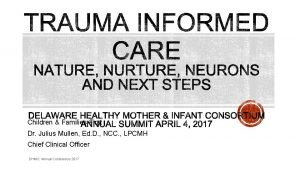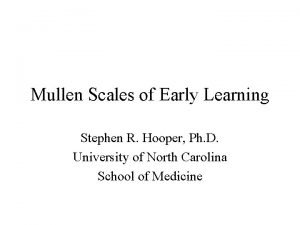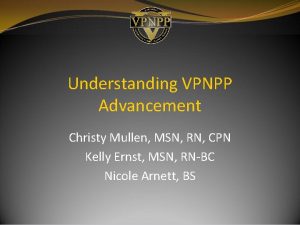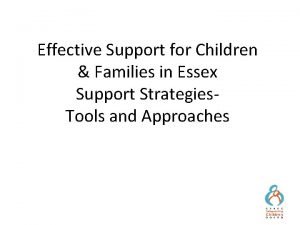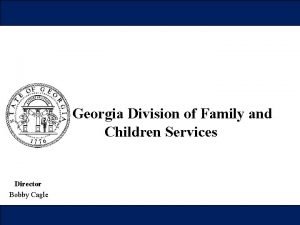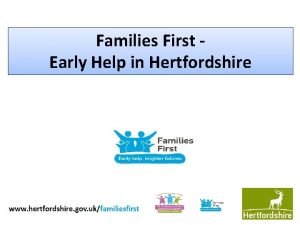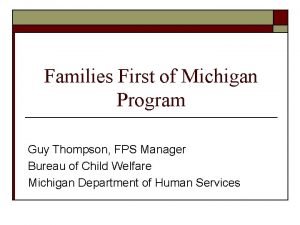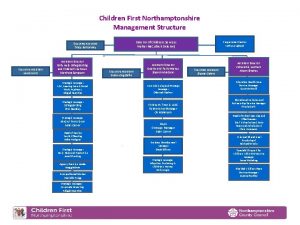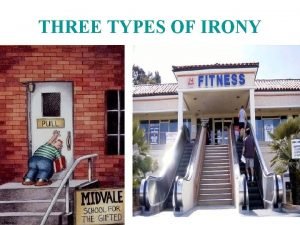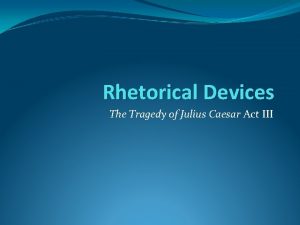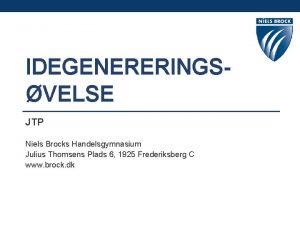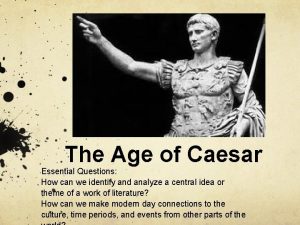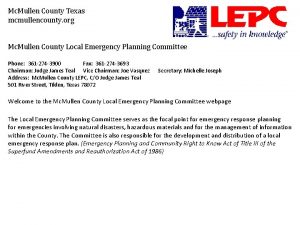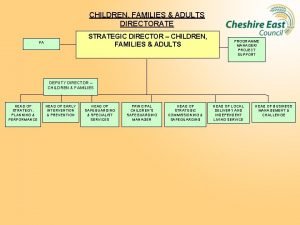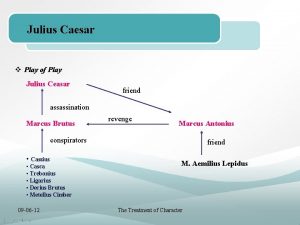Children Families First Dr Julius Mullen Ed D

































- Slides: 33

Children & Families First Dr. Julius Mullen, Ed. D. , NCC. , LPCMH Chief Clinical Officer DHMIC Annual Conference 2017

§ Multi-service organization serving kids and families throughout Delaware since 1884 § We help children facing adversity on their journey to adulthood. We use proven methods to help families raise their children so they can flourish. § Part of Brain Science collaborative of organizations in US and Canada § Goal: Transform our capacity to accelerate the integration and application of brain science within our organizations, communities, and the public sector systems in which we work. DHMIC Annual Conference 2017

§ Human Service Leader § Clinical Supervisor § Adjunct Professor (psychology, education and counseling) § Therapist/Mentor/Coach § Hubby/Dadddy/Pappi DHMIC Annual Conference 2017

1. 2. 3. 4. 5. 6. 7. 8. 9. Identify trauma and types of trauma Describe the ACE study Learn how trauma impact brain development and functioning Describe trauma, toxic stress and attachment issues Define resiliency Describe trauma informed care Identify trauma informed care principles Learn examples of potential trauma triggers Learn trauma informed care resiliency strategies DHMIC Annual Conference 2017

DHMIC Annual Conference 2017

§trau·ma (oxforddictionaries. com) §noun: trauma §a deeply distressing or disturbing experience. §Types of Trauma §Complex Trauma §Vicarious or Secondary Trauma DHMIC Annual Conference 2017

DHMIC Annual Conference 2017

§ 17, 000 adults who became members of Kaiser Permanente HMO in San Diego, between 1995 and 1997. § After visiting a primary care facility, voluntarily filled out a standard medical questionnaire that included questions about their childhood. § The questionnaire asked them about 10 types of child trauma: • Three types of abuse (sexual, physical and emotional). • Two types of neglect (physical and emotional). • Five types of family dysfunction (domestic violence, parental substance abuse, parental mental illness, divorced or separated parents, family member in jail/prison). DHMIC Annual Conference 2017

DHMIC Annual Conference 2017

DHMIC Annual Conference 2017

Those with 4+ § 2 x more likely to smoke § 2 x more likely to have cancer or heart disease § 4 x more likely to have emphysema § 6 x more likely to have sex before age of 15 § 7 x more likely to be an alcoholic § 10 x more likely to partake in IV drug use § 12 x more likely to attempt suicide DHMIC Annual Conference 2017

DHMIC Annual Conference 2017

DHMIC Annual Conference 2017

DHMIC Annual Conference 2017

DHMIC Annual Conference 2017

DHMIC Annual Conference 2017

Perry’s Toxic Stress and Neglect DHMIC Annual Conference 2017 Perry, 2006

FRONTAL LOBE and AMYGDALA § Impulse Control § Working Memory § Emotional Regulation § Planning/Prioritizing § Flexible Thinking § Task Initiation § Be a self starter/leader/role model § Self-Monitoring § Comprehend § Social Skills § Organization § Think about consequences § Express thoughts/feelings § Understand others § Focus on self responsibilities § Play nice with others DHMIC Annual Conference 2017 § Remember concepts § Place concepts/themes/numbers in order § Understand the gray/main idea § Keep your desk/folders neat and orderly

DHMIC Annual Conference 2017

DHMIC Annual Conference 2017

§The active ingredient in the environment that’s having an influence on development is the quality of the relationships that humans have with the important people in their lives. That’s what it’s all about. (Shonkoff, Center for the Developing Child at Harvard University) DHMIC Annual Conference 2017

DHMIC Annual Conference 2017

§ Taking things away § Removal of clothing § Threats (verbal threat then beating) § Being touched (different meaning) § Use of physical force (abuse) § Being observed or followed § Observing threats or assaults peers § Loud noises alarms, fire drills, § Isolation (“go in your room”, DV) § Lockdowns § Bomb threats § Physical restraints (SC student) § Changes in staff § Contact with authority figures DHMIC Annual Conference 2017 ambulance/sirens (CV) § Smells or scents that trigger memories (sexual abuse) § Teacher absence or illness § Escalation of another student § Side talking/conversations (must be talking about me)

§ Needy and/or clingy (seeking safety) § Afraid to go home at the end of the school day (school = safety) § Continuously scanning the environment (looking for danger) § Eloping away from the classroom/school § Inability to cope with stress § Inability to make and develop friendships § Antisocial behaviors and attitudes § Problems with expressive and receptive language (limited expressive vocab) § Lack of self-control/impulsivity § Hypervigilant (antennas always up) DHMIC Annual Conference 2017

STECCC §SAFETY §TRUSTWORTHINESS §ENCOURAGEMENT/EMPOWERNMENT §CULTURE §COLLABORATION §CHOICE DHMIC Annual Conference 2017

5 top attributes of your favorite teacher/school staff? 1. Maintain usual routines, safety and predictability 2. Give children choices which can provide a sense of control. 3. Provide extra adult support and a safe place to talk, draw to express themselves. 4. Set clear, firm, fair and consistent limits. Be logical with consequences rather than punitive. Nurturance and accountability. Tough one! 5. Understand that behavioral problems may be the best way for children to communicate traumatic experiences. DHMIC Annual Conference 2017

6. Be sensitive to potential triggers (shooter alarm, yelling, loud noises, dark rooms, etc) 7. Explain changes in routine or unpredictable events in advance. 8. Be aware that some children will reenact trauma through play or defiance toward adults. 9. Offer check ins and check outs. 10. Integrate real life experiences within context of content especially in small group settings. DHMIC Annual Conference 2017

11. Avoid engaging in power struggles 12. Avoid the “my way or the highway” approach- offer choices 13. Put behavior in context of the students’ life circumstances 14. Hit the reset button daily and try not to take things personally 15. Maintain consistent professional communication with formal and informal supports. DHMIC Annual Conference 2017

16. Develop and follow a consistent home/school communication plan with parents so you are aware of stressors or crises that occur outside of school 17. Be aware how medications affect the student and be on the lookout for changes in mood and/or behaviors 18. Keep good professional boundaries and be selective when disclosing personal information with colleagues 19. RELATIONSHIPS AND ACCOUNTABILITY! 20. BE RESILIENT AND HANG IN THERE! DHMIC Annual Conference 2017

§ Alberta Family Wellness (2013, October 10). How brains are built: The core story of brain development. Retrieved From the Alberta Family Wellness website: http: //www. albertafamilywellness. org/resources/video/how-brains-are-built-core-storybrain-development § Bowlby, J. (1988). A secure base: Parent-child attachment and healthy human development. New York: Basic Books § Burke-Harris, N. (2014). TEDMed. Retrieved From TEDMed website: https: //www. ted. com/talks/nadine_burke_harris_how_childhood_trauma_affects_health_ across_a_lifetime? language=en § Cameron, J. (2013). Vimeo. Retrieved from Vimeo website: https: //vimeo. com/73486867 § Center for Disease Control (2013). Retrieved From the Center for Disease Control website: http: //www. cdc. gov/violenceprevention/NISVS/index. html § Cole, Eisner, Gregory & Ristuccia, (2013). Helping traumatized children learn: Creating and advocating for trauma-sensitive schools. Massachusetts Advocates for Children: Harvard Law School § Fallot, R. D. , & Harris, M. (2009). Creating cultures of trauma informed care: A self assessment and planning protocol. Washington DC: Community Connections DHMIC Annual Conference 2017

§ Felitti, V. J. , & Anda, R. F. (1997). The adverse childhood experiences (ACE) study. Centers for Disease Control and Prevention website. Retrieved from http: //www. cdc. gov/ace/index. htm § Finkelhor, D. , Turner, H. A. , Shattuck, A. , & Hamby, S. L. (2013). Violence, crime, and abuse exposure in a national sample of children and youth. JAMA Pediatrics, 167(7): 614 -621. doi: 10. 1001/jamapediatrics. 2013. 42. § Green, R. R. , & Conrad, A. P. (2001). Resilience: An integrated approach to practice, policy, and research. Washington D. C. : NASW Press. § National Resource Center for Mental Health Promotion and Youth Violence Prevention (2012). Retrieved From the National Resource Center for Mental Health Promotion and Youth Violence Prevention website: http: //www. healthysafechildren. org/ § Perry, B. & Szalavitz, M. (2006). The boy who was raised like a dog. New York: Basic Books § Shonkoff, J. (2015). Center for the Developing Child at Harvard University In. Brief. Retrieved from Center for the Developing Child website: http: //developingchild. harvard. edu/resources/inbrief-the-science-of-resilience/ DHMIC Annual Conference 2017

DHMIC Annual Conference 2017

DHMIC Annual Conference 2017
 Dhmic
Dhmic Little families
Little families Mullen scales of early learning
Mullen scales of early learning Jacob riis photographs analysis
Jacob riis photographs analysis Vpnpp
Vpnpp Effective support for children and families in essex
Effective support for children and families in essex Georgia department of children and families
Georgia department of children and families Families first assessment
Families first assessment Families first michigan
Families first michigan Children first northamptonshire
Children first northamptonshire Shakespeare webquest answers
Shakespeare webquest answers Rising action of julius caesar
Rising action of julius caesar What are the three types of irony and their definitions
What are the three types of irony and their definitions Julius caesar background
Julius caesar background Julius caesar act two summary
Julius caesar act two summary Julius caesar setting
Julius caesar setting Poem about julius caesar
Poem about julius caesar Veni, vidi, vici shakespeare
Veni, vidi, vici shakespeare Julius claudius dinasztia
Julius claudius dinasztia Julius caesar rise to power
Julius caesar rise to power Rhetoric in julius caesar
Rhetoric in julius caesar Julius caesar character list
Julius caesar character list Julius caesar
Julius caesar Julius caesar buildings
Julius caesar buildings Julius elefante
Julius elefante Julius caesar
Julius caesar Motifs in julius caesar
Motifs in julius caesar Niels brock jtp
Niels brock jtp Romai legio
Romai legio Julius caesar essential questions
Julius caesar essential questions Put the following events in chronological order history
Put the following events in chronological order history Does cassius die in julius caesar
Does cassius die in julius caesar Tom suk
Tom suk Shakespeare webquest
Shakespeare webquest
